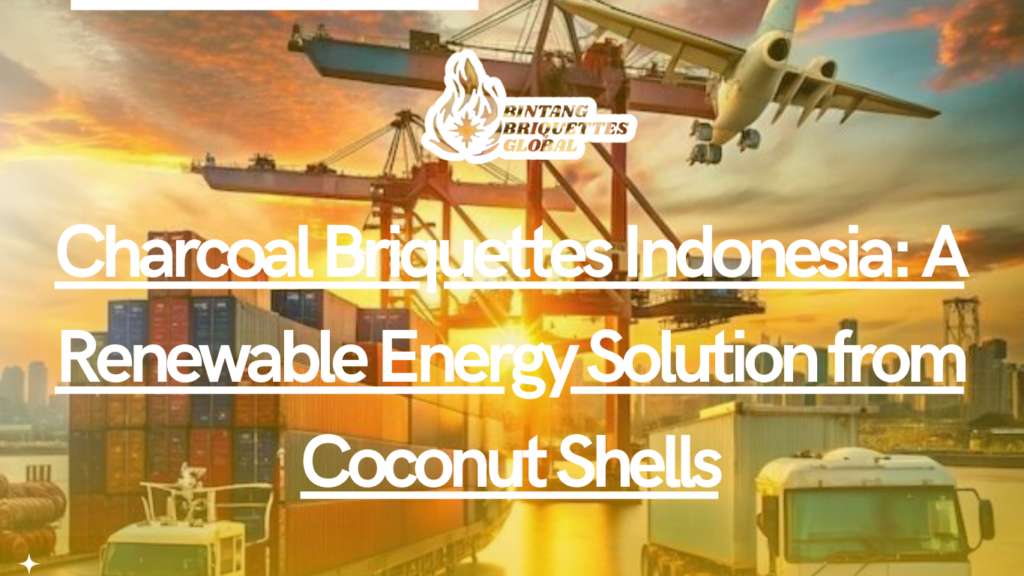
Coconut shell charcoal briquettes are a sustainable and renewable energy solution that is gaining traction worldwide. These eco-friendly briquettes are made from coconut shells, which are a natural byproduct of Indonesia’s coconut industry. As the world faces the growing threat of climate change, the search for renewable and sustainable energy sources becomes more critical than ever. Among the many alternative energy solutions, coconut shell charcoal briquettes from Indonesia stand out as a unique and highly beneficial option. This article explores in detail the importance of coconut shell charcoal briquettes as a renewable energy source, the production process behind them, their environmental and economic benefits, and their increasing role in global markets. Furthermore, we will look at the potential for this industry to grow in the future and its alignment with global sustainability goals.
What Are Charcoal Briquettes?
Charcoal briquettes are solid fuel blocks made by compressing charcoal, which is produced through the carbonization of organic materials such as wood, agricultural residues, or coconut shells, in an oxygen-deprived environment. The carbonization process involves heating the material to high temperatures, removing moisture and volatile compounds, leaving behind solid carbon-rich charcoal. The resulting briquettes are uniform, dense, and compact, providing a fuel source that burns longer and produces more heat than raw wood or coal.
Briquettes have many advantages over traditional fuels such as firewood or coal. They burn more efficiently, with less smoke, and they produce fewer harmful emissions. This makes them an environmentally friendly and cost-effective energy source for various uses, including household cooking, industrial heating, and even large-scale power generation.
Why Coconut Shells?
Coconut shells, a byproduct of the coconut industry, have long been underutilized and often discarded. Indonesia, one of the largest producers of coconuts in the world, generates millions of tons of coconut shells annually. Historically, these shells were either burned, left to decompose, or sent to landfills, contributing to environmental waste and inefficiency.
Coconut shells, however, are rich in carbon and have a high density, making them an excellent material for charcoal production. In fact, coconut shells contain more carbon than wood, making them an ideal resource for creating high-quality charcoal briquettes that burn hotter and longer than traditional fuels. Furthermore, using coconut shells for charcoal production helps address two major environmental concerns: reducing waste and mitigating deforestation.
Coconut shells are renewable and replenished each year as part of the coconut harvest. This renewable nature makes them a sustainable alternative to wood-based charcoal, which requires cutting down trees and contributes to deforestation. By utilizing coconut shells, Indonesia can reduce pressure on its forests and move toward more sustainable energy practices.
The Charcoal Briquette Production Process
The production of coconut shell charcoal briquettes is a multi-step process that involves several stages to ensure the final product meets both environmental and performance standards. Let’s look at each stage in more detail:
1. Collection and Preparation
The first step in the production of coconut shell charcoal briquettes is the collection of coconut shells. These shells are sourced from coconut plantations, processing facilities, and even local villages. After collection, the shells are cleaned thoroughly to remove any residual coconut meat, fibers, or other impurities. This step ensures that the carbonization process is not disrupted by contaminants, which could affect the quality of the final product.
2. Carbonization
The next step involves carbonizing the coconut shells. Carbonization is the process of heating the shells in a low-oxygen environment, typically within a kiln or furnace, at temperatures between 400°C and 600°C. During this process, volatile gases and water are driven off, leaving behind a carbon-rich material known as charcoal. This step is crucial as it produces a high-carbon content material that is ideal for making efficient and long-burning briquettes. Carbonization typically takes several hours, depending on the type of kiln used, but it results in a stable, durable product.
3. Crushing and Grinding
After carbonization, the charcoal is crushed into smaller pieces or powder to make it easier to handle and prepare for briquette production. Crushing helps achieve uniformity in size, which is important for ensuring consistent performance during burning. Charcoal powder is commonly used in briquette production, but larger charcoal pieces can also be ground into smaller particles.
4. Mixing with Binders
Charcoal powder by itself is not enough to form stable briquettes. To bind the charcoal particles together, a binder such as starch, tapioca flour, or natural gums is added. The binder helps hold the charcoal powder in place during compression, ensuring the briquettes maintain their shape and integrity. It also plays a role in improving the briquette’s density and combustion properties.
5. Briquetting
Once the charcoal powder is mixed with the binder, the mixture is loaded into a briquetting machine. The machine applies high pressure to form the mixture into compact, uniform shapes, such as cylindrical, hexagonal, or pillow-shaped briquettes. Compression ensures that the briquettes are dense, durable, and free from cracks, which is crucial for achieving an even and efficient burn.
6. Drying
After briquetting, the briquettes must be dried to remove any remaining moisture. High moisture content can affect the burn quality, causing inefficient combustion, increased smoke, and reduced heat output. Drying can be done in drying ovens, or in some cases, the briquettes are dried naturally under the sun. Proper drying ensures that the briquettes will burn cleanly and efficiently.
7. Packaging and Distribution
Once dried, the briquettes are ready for packaging. They are packed into bags of various sizes, depending on market demand, and prepared for distribution. Indonesia exports coconut shell charcoal briquettes to markets worldwide, including Europe, the Middle East, and Asia, where they are used in industries, commercial enterprises, and households.
Environmental Benefits of Coconut Shell Charcoal Briquettes
Coconut shell charcoal briquettes offer several key environmental benefits that make them a highly sustainable energy source:
- Sustainability and Renewability Coconut shells are a renewable resource, replenished annually by the coconut industry. Unlike fossil fuels, which are finite and contribute to environmental degradation, coconut shells can be sustainably harvested year after year. This makes them a vital part of the renewable energy sector.
- Reduction of Deforestation The production of charcoal is often a major driver of deforestation, with large amounts of wood being cut down to create fuel. By using coconut shells, Indonesia reduces the need for wood-based charcoal and helps protect valuable forests, ecosystems, and biodiversity.
- Cleaner Burning Traditional fuels like firewood and coal can release large amounts of smoke, particulate matter, and harmful pollutants into the air, leading to air pollution and health issues. Coconut shell charcoal briquettes, on the other hand, burn cleaner, with less smoke and fewer emissions. This helps improve air quality, particularly in areas that rely on traditional cooking methods.
- Waste Reduction Coconut shells are often discarded as waste, contributing to environmental pollution. By converting them into charcoal briquettes, Indonesia is diverting waste from landfills and reducing the harmful practice of open-air burning, which releases toxic pollutants into the atmosphere.
Economic Benefits of Coconut Shell Charcoal Briquettes in Indonesia
The production of coconut shell charcoal briquettes has had a significant impact on the economy of Indonesia. The economic benefits are felt across various sectors of the economy:
- Job Creation The charcoal briquette industry creates jobs at every stage of production, from collecting coconut shells to the final packaging and distribution of the briquettes. This is particularly important in rural areas, where job opportunities can be limited. It also supports local businesses and provides income for smallholder farmers involved in coconut production.
- Export Opportunities As a leading producer of coconuts, Indonesia has seen the growing global demand for sustainable and clean energy sources create new export opportunities for coconut shell charcoal briquettes. Countries in Europe, the United States, and the Middle East are among the largest importers, helping Indonesia improve its trade balance and contribute to economic growth.
- Diversification of the Agricultural Sector The use of coconut shells for charcoal production helps diversify Indonesia’s agricultural sector. By adding value to coconut shells, the country can reduce its reliance on traditional coconut-based products like coconut oil and copra. This diversification creates new revenue streams for farmers and strengthens the overall resilience of the agricultural economy.
- Increased Local Investment The growing demand for coconut shell charcoal briquettes has driven investment in local production facilities, infrastructure, and innovation. This fosters economic growth in areas with abundant coconut plantations and promotes sustainable business practices in agriculture and manufacturing.
Conclusion
Coconut shell charcoal briquettes offer a powerful and sustainable solution to the growing demand for cleaner energy. Indonesia’s abundant coconut resources and efficient production methods position the country as a leader in the global renewable energy market. The environmental, economic, and social benefits of coconut shell charcoal briquettes emphasize their role in creating a cleaner, more sustainable future. By utilizing this resource, Indonesia is advancing global sustainability and establishing itself as a key player in the shift toward a greener world.
